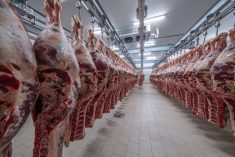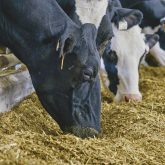High-tech livestock ear tags are a step closer to reality in Alberta, thanks to a recent big dollar commitment towards a trial of Ultra High Frequency (UHF) tags.
The end-to-end test will track animals through all parts of the beef production cycle, from the producer’s field, through auction markets, feedlots and to the processor. The trial will also test all of the associated software and hardware required along the way, including readers to collect data, computer programs to move and analyze data, and systems to integrate the information with Livestock Identification Services (LIS) and the Canadian Cattle Identification Agency databases.
Read Also

Ample supplies and improved livestock sector to boost Canadian feed sector: FCC
Abundant feed grain supplies and improved profitability for the livestock sector should support strong feed demand and sales through the winter, says a new report from Farm Credit Canada.
“This is much bigger than just reading tags,” said David Moss, chief operating officer at LIS. “That’s what makes this trial so much more realistic.”
The trial has received major funding from the Alberta Livestock and Meat Agency (ALMA) and support from LIS and Alberta Agriculture. It is being spearheaded by Southern Alberta Institute of Technology (SAIT) students and will see 1,200 head of Alberta cattle from all sectors of the industry sporting UHF tags within weeks.
Ultimately, the trial is a proof of concept in a full commercial setting, said Moss.
“At the end of the trial, we’re hoping to have confidence in the technology — the ability to say that it does work; that in terms of readability and retention, all the things we were promised are delivered. We want to have a product that is market-ready and proven.”
Current RFID tag technology is not meeting industry expectations, said Moss.
“The current low-frequency technology currently approved for use in Canada appears to be struggling to operate at the speed of commerce; and there is concern over retention and cost. UHF may be able to address all of these concerns, and thanks to ALMA funding, that is what we hope to reveal through this comprehensive trial.”
UHF tags may solve the readability issue, and much more. Unlike regular tags, multiple tags can be read per second at any orientation and from a range of up to 60 feet. Each tag offers 65 Kb of read/write data storage capacity. As well, tags and readers will likely cost much less than the current tag technology. The tags are proven in multiple inventory-tracking applications, from retail merchandise through police asset assignment. What remains to be seen is whether they will work given the requirements of cattle production.
Moss believes they will. Two years ago, he approached SAIT’s Glenn Kathler to ask if students in his Radio Frequency Identification lab could help apply UHF technology in the cattle industry. The students immediately put their heads to the challenge. The prototypes they designed embed UHF technology in a tag similar to traditional tag designs that have proven retention rates.
If all goes well with the trial, the next hurdle for large-scale implementation of UHF technology in Alberta cattle herds will be Canadian Food Inspection Agency (CFIA) approval.
“The CFIA appears apprehensive to considering new technologies,” said Moss. “We’re going to really have to do our homework to provide a compelling case to them.”
For the time being, Moss is focusing his energy and hopes on a successful trial. Given the political nature of livestock identification and traceability, the fact that this trial is taking place is a major achievement.
“Accolades go to ALMA for having the vision and SAIT for having the know-how to make it happen,” said Moss.















